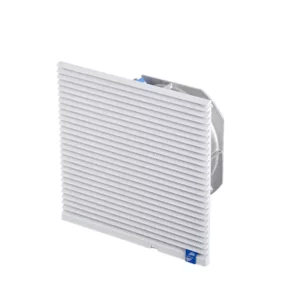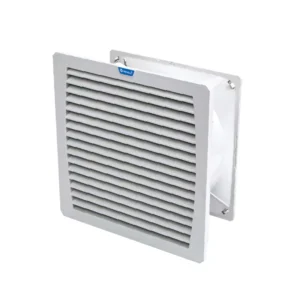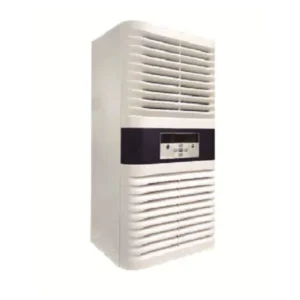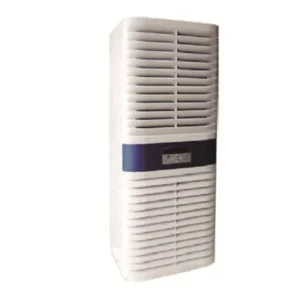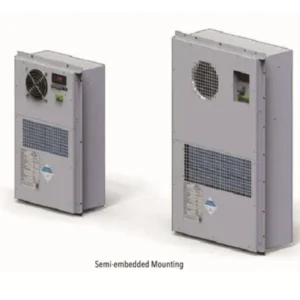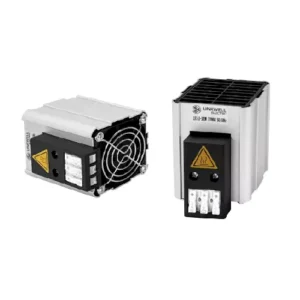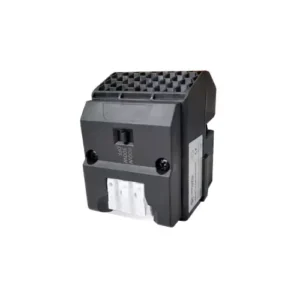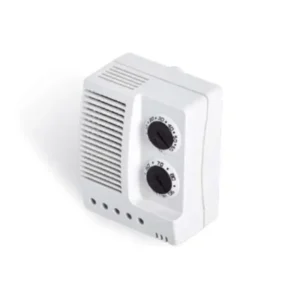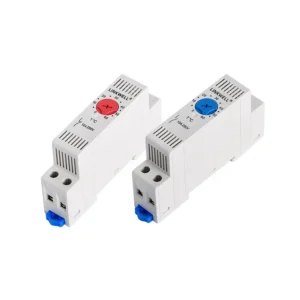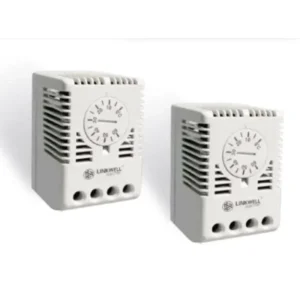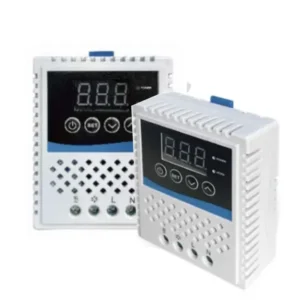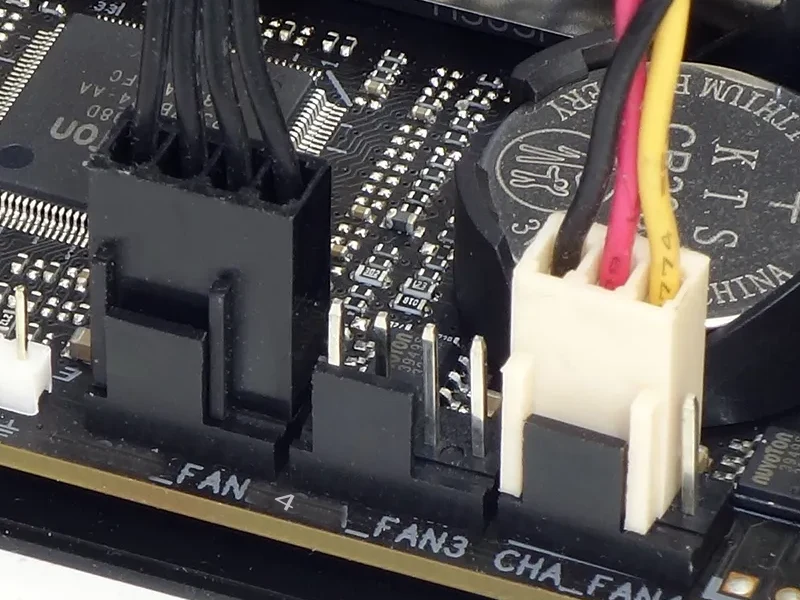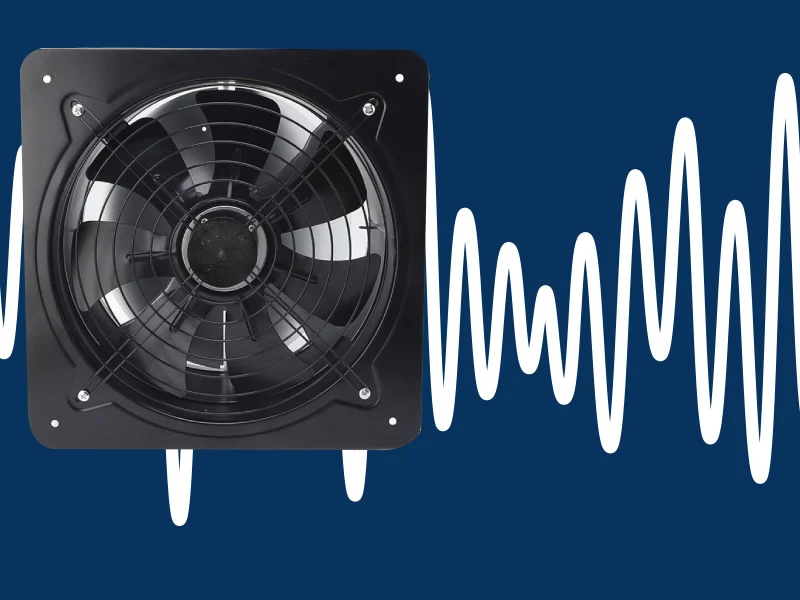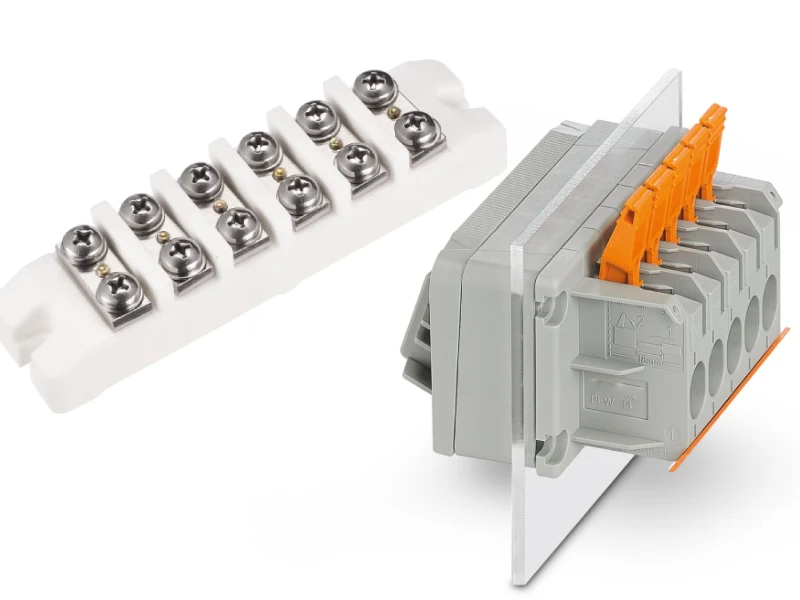In today’s world, where renewable energy is becoming the heartbeat of residential and commercial infrastructure, safely storing that power is just as important as generating it. That’s where solar battery enclosures come into play.
What is Solar Battery Enclosures
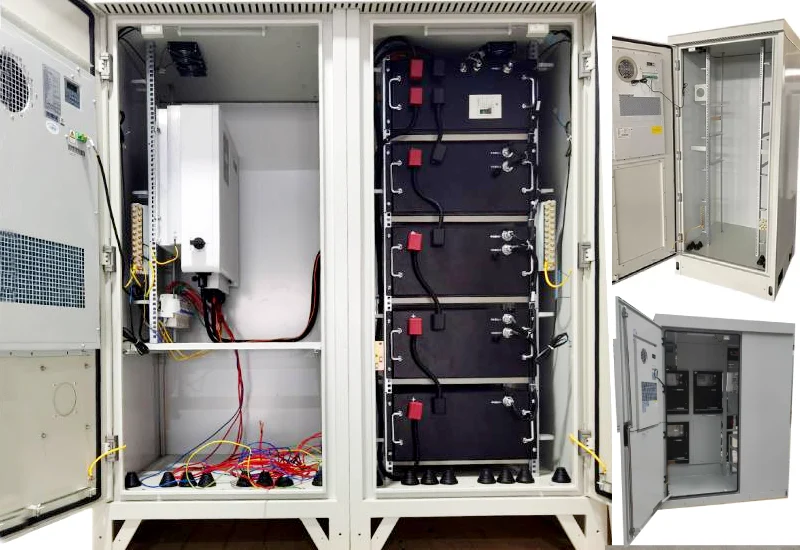
At first glance, an enclosure might seem like just a box. But in reality? It’s the nerve center of your solar storage system—protecting everything from batteries to sensitive electronics. Battery enclosure for solar system guards against rain, dust, pests, temperature extremes, and unauthorized access. More importantly, it shields your setup from the biggest threat to battery safety: overheating.
As a seasoned modular enclosure system manufacturers, we’ve seen firsthand how the right design and the right thermal management system can make or break your setup. That’s why this guide takes you beyond the basics—deep into the components, real-world applications, and our trusted technologies.
The Role of Enclosure Manufacturers in Renewable Energy
Designing for the solar industry isn’t guesswork—it’s engineering based on years of feedback, regulatory scrutiny, and performance testing. As a professional manufacturer of electrical enclosures, terminal blocks, and CMS cable management systems, we don’t just build boxes. We build safe spaces that can handle extreme environments and fluctuating energy loads.
From rooftop solar farms to utility-scale battery banks, our clients trust us to deliver Solar Battery Enclosure that are more than compliant—they’re future-proofed, rugged, and smartly engineered. And yes, we geek out over thermal calculations, airflow ratios, and humidity curves—because that’s what excellence demands in this industry.
Key Components Inside a Solar Battery Enclosure
Recommended products
Inside every quality solar battery enclosure, several vital components work in harmony:
- Electrical Box: The core housing for terminal blocks, power relays, and controllers. Designed with fire-rated materials and ergonomic access points.
- CMS Cable Management System: Keeps cables organized, reduces electrical interference, and enhances maintenance accessibility.
- Terminal Blocks: Secure, vibration-resistant, and neatly labeled connections that meet IEC standards.
- Battery Management System (BMS): Your smart guard—it monitors voltage, temperature, current, and ensures the batteries charge/discharge safely.
- Circuit Protection: Fuses, breakers, and surge arrestors built to international codes like IEC 60269-7 and NEC 240.
But this well-oiled machine runs hot—literally. That’s where thermal management becomes critical.
Why Thermal Management is Crucial in Solar Battery Enclosure Design
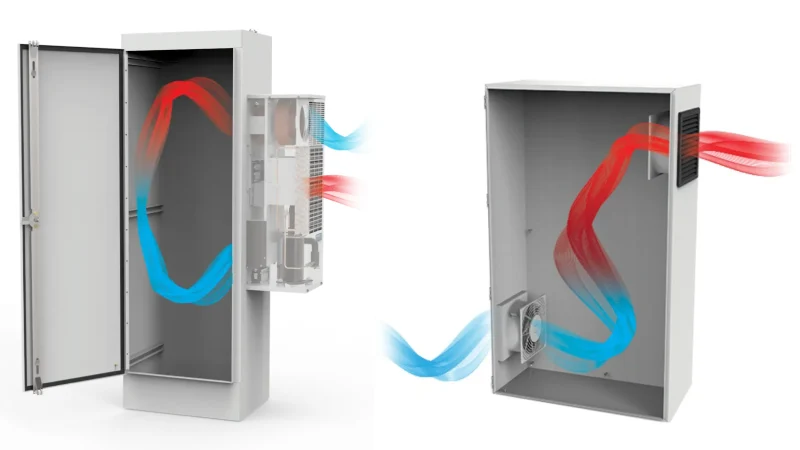
Do Electrical Enclosures Need Ventilation? Solar Battery Enclosure often operate in challenging climates—rooftops in Texas, coastal warehouses, or even snowy fields in Canada. And when batteries heat up, they degrade faster, lose capacity, and in extreme cases, catch fire.
Take lithium-ion batteries. They’re sensitive creatures. Once internal temperatures hit 60°C (140°F), they risk thermal runaway—a dangerous, self-feeding reaction. Even sealed lead-acid batteries release gas under heat.
That’s why we equip every professional-grade enclosure with a thermal management system. Whether it’s a smart thermostat triggering a cooling fan or a rugged heater kicking in on freezing nights—managing temperature is not optional. It’s life-saving.
Fan and Filter Units: Simple Yet Powerful Cooling
Recommended products
Let’s start simple: fan and filter kits. These might be the most cost-effective way to introduce airflow into your enclosure. We recommend these especially in moderate climates or well-ventilated indoor locations.
Benefits:
- Keeps Solar Battery Enclosure internal temperatures stable by circulating air
- Prevents buildup of hydrogen gases from lead-acid batteries
- Filters out dust and insects that can clog vents or corrode terminals
Pro Tip: Position your fan on the lower side of the enclosure (for intake) and the filter on the upper side (for exhaust). This natural convection pattern—cold air in, hot air out—is energy-efficient and reliable.
Our fans come pre-fitted with IP-rated housings and noise-dampening mounts. One of our industrial clients in Arizona reported a 28% drop in battery-related service calls after installing our fan and filter combo.
Cabinet Air Conditioners: Maximum Cooling for Demanding Environments
Recommended products
When you’re Solar Battery Enclosure dealing with high ambient temperatures—think deserts, unshaded rooftops, or factories near furnaces—fans aren’t enough. That’s when our Cabinet Air Conditioners take the lead.
These aren’t your home AC units. They’re compact, sealed systems designed to:
- Cool internal temps down by up to 35°C
- Withstand dust, salt, and vibration
- Operate 24/7 with programmable load balancing
Our models are equipped with smart controllers that adapt fan speeds and compressor cycles based on real-time Solar Battery Enclosure heat. This not only preserves battery life but also cuts power consumption by 15–20% on average.
A major solar operator in Southeast Asia recently standardized on our cabinet air conditioners, reporting “game-changing uptime improvements” across their distributed storage units.
Enclosure Heaters: Protection in Cold Climates
Cold weather might not sound threatening—until your batteries refuse to charge or condensation shorts your circuitry.
Enter our enclosure heaters. These compact devices are designed to:
- Prevent battery freezing
- Reduce humidity buildup
- Maintain operational temperature thresholds (e.g., 5°C–10°C for lead-acid)
Paired with thermostats or hygrostats, they only run when necessary—saving energy while protecting vital components. We offer both PTC heaters (self-regulating) and fan-assisted models for even heat distribution.
In Canada’s Alberta province, an EV charging station operator chose our Solar Battery Enclosure heater assemblies and reported zero cold-related failures through winter. That’s the kind of performance that builds trust.
Thermostats & Hygrostats: Smart Environmental Monitoring
Recommended products
Let’s be honest—temperature swings and humidity spikes are a silent killer for batteries and sensitive electronics. That’s why thermostats and hygrostats are no longer optional—they’re vital.
Our systems integrate digital thermostats and precision hygrostats that monitor:
- Internal Solar Battery Enclosure temperature
- Relative humidity levels
- Dew point to prevent condensation
Once thresholds are exceeded, these smart sensors trigger cooling fans, heaters, or air conditioners to restore safe levels. For example, one of our German-based EV fleet partners uses our hygrostat-controlled heaters to maintain optimal conditions during foggy, humid winters. The result? Zero incidents of moisture corrosion or battery failure over two years.
With industrial-grade thermostats calibrated for extreme conditions, and DIN rail-mounted versions for easy installation, we make it simple for you to maintain a stable microclimate in every Solar Battery Enclosure—automatically.
Ensuring Code Compliance & Industry Certification
Let’s face it—cutting corners on compliance can be costly. At best, you face delays or failed inspections. At worst? System failure, injury, or legal liability.
As a leading Solar Battery Enclosure manufacturer, we ensure all our enclosures and cooling systems meet or exceed relevant standards:
| Certification/Standard | What It Ensures |
|---|---|
| UL 9540 / 9540A | Energy storage and fire behavior safety |
| UL 1973 | Stationary battery compliance |
| NEMA 3R / 4X | Weather, dust, and corrosion protection |
| IP65 / IP66 | Ingress protection from water and particles |
| NFPA 855 / NEC 706 | Fire code compliance for ESS installation |
| IEC 60269-7 | Fuse and protection standards |
One of our largest Solar Battery Enclosure U.S. wholesalers once said, “We used to have issues with local fire marshals red-tagging non-compliant enclosures. Since switching to your UL and NEMA-rated cabinets, not a single unit’s been flagged.”
That’s the peace of mind compliance delivers—and it’s built into every unit we ship.
Materials and Build: Choosing Durable, Weather-Ready Enclosures
Durability isn’t just about thick steel—it’s about smart materials, intelligent sealing, and long-term corrosion resistance.
Our enclosures are built from:
- 304 & 316 stainless steel for coastal or chemical environments
- Powder-coated aluminum for lightweight durability
- UV-stabilized polycarbonate panels for solar resistance
We also integrate:
- Gasketed seals with anti-aging rubber compounds
- Vibration-isolated mounting brackets
- Dual-wall insulation for thermal stability
Need a desert-proof enclosure? We’ve got it. Need a salt-resistant cabinet for an offshore wind farm? That’s our specialty.
A customer in Dubai’s solar industry told us: “We had competitor enclosures fail after two summers—yours are still performing flawlessly, even with sandstorms and 50°C heat.”
That’s real-world validation.
Safety Features & Design Best Practices
It’s not enough for an enclosure to be strong. It also has to be smart, safe, and user-friendly.
That’s why our standard features include:
- Clear labeling and system schematics inside every door
- Surge arrestors and inline fusing on terminal blocks
- Tamper-proof locks and hinges
- Fully grounded CMS systems
We also design with future upgrades in mind—providing extra DIN rail space, removable panels, and tool-less access for maintenance. Whether you’re an installer or a field technician, you’ll appreciate how easy our systems are to work with.
Safety doesn’t happen by accident. It’s engineered into every screw, wire, and latch.
Installation Tips for Optimal Performance
Even the best enclosure won’t perform well if it’s poorly installed. Based on thousands of real-world deployments, here are our top tips:
- Placement: Avoid south-facing walls in direct sun. Use shades or shelters where possible.
- Elevation: Mount on a raised platform or wall to avoid water damage or pest intrusion.
- Airflow: Ensure at least 20% of the internal space is free for ventilation.
- Cable routing: Use CMS systems to prevent kinks, friction points, or EM interference.
- Access clearance: Leave space around the unit for servicing and airflow—especially near fans or vents.
Professional installation ensures not only system longevity but also compliance with NEC, NFPA, and PAS 63100.
Real-World Feedback: What Customers Are Saying
Nothing speaks louder than the words of those in the trenches—installers, wholesalers, and project managers who depend on our enclosures every day.
- Installers love our quick-mount brackets and pre-drilled templates.
- Distributors appreciate our consistent QC and on-time shipping.
- Technicians value the internal layout that makes diagnostics and maintenance quick and hassle-free.
Here’s what one client from Scandinavia said:
“Your thermostat-controlled heaters saved our batteries during a -15°C cold snap last winter. We’ve since upgraded all 42 sites to your thermal management enclosures. Worth every cent.”
Another U.S. EPC contractor shared:
“We used to buy fans separately and retrofit them into cheap boxes. That changed when we found your all-in-one cabinets. They’re built like tanks and just… work.”
DIY vs. Commercial Enclosures: Which Is Right for You?
DIY enclosures have their place—small, low-voltage setups in garages or hobbyist projects. But for grid-tied solar, ESS, or lithium-ion battery systems, commercial enclosures are the clear choice.
| Feature | DIY Enclosures | Commercial Enclosures (Ours) |
|---|---|---|
| Thermal Control | Minimal | Integrated AC, fans, heaters |
| Compliance | Rare | UL/NEMA/IP rated |
| Material Strength | Basic (wood/plastic) | Industrial-grade steel/aluminum |
| Fire Safety | Limited | Certified fire-rated systems |
| Long-Term ROI | Low | High—less downtime, fewer replacements |
The truth? You can’t afford to cut corners when it comes to power storage. Not when safety, uptime, and asset protection are on the line.
Future-Proofing Your System
One of the most overlooked aspects of enclosure design is scalability. Power needs grow. Regulations tighten. Technology evolves.
That’s why we build with tomorrow in mind:
- Extra internal space for new batteries or BMS upgrades
- Removable panels and modular CMS kits
- Smart sensor integration for remote monitoring and alerts
You won’t need to “rip and replace” when your storage expands—we design enclosures that grow with you.
FAQs
Q1: Can I install a solar battery enclosure outdoors in extreme heat?
A: Yes, but ensure it’s NEMA 4X rated with proper cooling—preferably a cabinet air conditioner and thermal insulation.
Q2: Do all battery types need cooling systems?
A: Not all, but lithium-ion and lead-acid batteries perform significantly better and safer with active cooling.
Q3: How often should I service the fan or filter units?
A: Check filters every 3–6 months, especially in dusty areas. Fans typically last 3–5 years.
Q4: What temperature range do your heaters support?
A: Our enclosure heaters maintain performance down to -40°C and are self-regulating above 10°C.
Q5: Can your enclosures be wall-mounted?
A: Absolutely. We offer models with reinforced backplates for wall or pole mounting, with vibration dampening.
Q6: Are your systems compatible with BMS and remote sensors?
A: Yes. Our enclosures support most BMS units and can integrate IoT sensors for remote monitoring.
Conclusion
When it comes to storing solar energy, an enclosure is more than just protection—it’s your system’s lifeline. And at the heart of that protection lies thermal management.
From fan-filter combos to smart air conditioners and precision thermostats, our solutions don’t just meet expectations—they exceed them. They’ve been tested in deserts, frozen tundras, salty docks, and scorching factories—and they’ve delivered.
As a professional enclosure manufacturer with a portfolio trusted by global clients, we understand the stakes. That’s why every component we design, every standard we meet, and every customer we serve reflects one promise: performance that protects.




